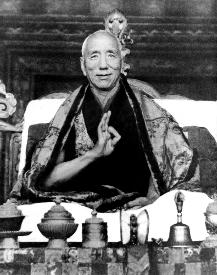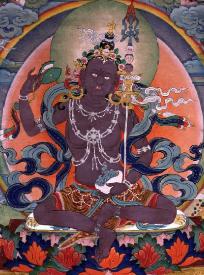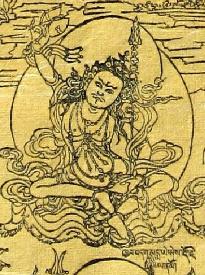
Teacher: Jamyang Khyentse Chokyi Lodro
Khyentse Chokyi Lodro | Jamyang Khyentse Wangpo Main Page
See the Life of Jamyang Khyentse Chökyi Lodrö by Orgyen Tobgyal Rinpoche
Biography:
 Dzongsar Khyentse Chokyi Lodro, 1893-1959, (rdzong gsar mkhyen brtse chos kyi blo gros) was born in sa-ngan, in the Dege region of Kham, in 1893. His father was Rigdzin Gyurme Tsewang Gyalpo (rig 'dzin 'gyur med tshe dbang rgyal po) and his mother was Tsultrim Tso (tshul khrims 'tsho). His clan was Chaggong (lcag gong). His paternal grandfather was Serpa Tergan (gser pa gter rgan), a lineage holder of the treasures of Dudul Dorje (bdud 'dul rdo rje). He was given the name Jamyang Chokyi Lodro ('jam dbyangs chos kyi blo gros).
Dzongsar Khyentse Chokyi Lodro, 1893-1959, (rdzong gsar mkhyen brtse chos kyi blo gros) was born in sa-ngan, in the Dege region of Kham, in 1893. His father was Rigdzin Gyurme Tsewang Gyalpo (rig 'dzin 'gyur med tshe dbang rgyal po) and his mother was Tsultrim Tso (tshul khrims 'tsho). His clan was Chaggong (lcag gong). His paternal grandfather was Serpa Tergan (gser pa gter rgan), a lineage holder of the treasures of Dudul Dorje (bdud 'dul rdo rje). He was given the name Jamyang Chokyi Lodro ('jam dbyangs chos kyi blo gros).Writings by Jamyang Khyentse Chokyi Lodro
After Jamgon Kongtrul ('jam mgon kong sprul) recognized the young Chokyi Lodro as the activity incarnation ('phrin las kyi sprul pa) of Jamyang Khyentse Wangpo ('jam dbyangs mkhyen brtse'i dbang po), the boy was taken to Dzongsar (rdzong sar) monastery. However, following a request by the 3rd Katog Situ Chokyi Gyatso (kaH thog si tu 03 chos kyi rgya mtsho), the nephew of Khyentse Wangpo, Chokyi Lodro was installed at Katog.
Chokyi Lodro received his novice vows at Katog and began his education there. He was given the name Tsuglag Lungrig Mawai Sengge (gtsug lag lung rigs smra ba'i seng ge). Tartse Shabdrung (thar rtse zhabs drung) also gave him the name Jamyang Chokyi Lodro Rime Tenpai Gyaltsen ('jam dbyangs chos kyi blo gros ri med bstan pa'i rgyal mtshan). He enrolled in Katog's new monastic college, studying the great treasuries compiled by his predecessor and Kongtrul, and the standard Indian and Tibetan Mahayana commentaries.
Seven years later, at the age of fifteen, Chokyi Lodro was summoned to Dzongsar Monastery at the behest of Kalsang Dorje (skal bzang rdo rje), Khyentse Wangpo's nephew and trustee. Khyentse Wangpo's 'body' incarnation, who had been installed at Dzongsar, had suddenly passed away, and he was sought as a replacement. Thus Chokyi Lodro again transferred to Dzongsar and was installed as the head of the monastery.
Over the course of his life Dzongsar Khyentse, as he was commonly known, studied with many of his predecessor's most eminent disciples. Regarding the Sakya teachings, Jamyang Loter Wangpo ('jam dbyangs blo gter dbang po) transmitted the Lamdre and Hevajra, and gave him most of the empowerments of Gyude Kundu (rgyud sde kun 'dus), the Compendium of Tantra that he and Khyentse Wangpo had compiled. Dragra Shabdrung Tashi Gyamtso (brag ra zhabs drung bkra shis rgya mtsho) taught him the Mitra Gyatsa (mi tra brgya rtsa), the Ngor Lamdre lineage of Ngagwang Chodrag (ngag dbang chos grags), and the Ra (rwa) and Tsar (tshar) lineages of Vajrabhairava.
At Dege Lhundrub Teng (sde dge lhun grub steng) Chokyi Lodro studied with Khenchen Samten Lodro (mkhan chen bsam gtan blo gros), receiving the transmission and empowerment of the Drubtab Kundu (sgrub thabs kun 'dus), the compendium of sadhana that Jamyang Khyentse and Loter Wangpo compiled. Shar Lama Jamyang Khyenrap Taye (shar bla ma 'jam dbyangs mkhyen rab mtha' yas) gave him the Kalachakra in Buton's (bu ston) lineage, and Tartse Shabdrung Jampa Kunzang Tenpai Nyima (thar rtse zhabs drung byams pa kun bzang bstan pa'i nyi ma) completed the transmission of the Gyude Kundu.
At Palpung (dpal spungs) Chokyi Lodro received teachings in the Sakya, Kadam, and Shangpa Kagyu traditions from Lama Tashi Chopel (bla ma bkra shis chos 'phel), namely the Khon ('khon) lineage of Vajrakila, the Kalachakra of Atisha, and the entire corpus of the Shangpa Kagyu. Gaton Ngagwang Legpa (rga ston ngag dbang legs pa) also transmitted additional Lamdre cycles. Tai Situ gave him Marpa Kagyu teachings of Hevajra and White Tara, and the son of the 15th Karmapa Kakyab Dorje (kar+ma pa 15 mkha' khyab rdo rje), the reincarnation of Jamgon Kongrul, Karse Kongtrul Khyentse Ozer (kar sras kong sprul mkhyen brtse 'od zer), gave him Ratna Lingpa's (rat+na gling pa) Vajrakila treasure cycle as well as Jamgon Kongtrul's own revelations. The 10th Zurmang Trungpa, Karma Chokyi Nyinje (zur mang drung pa 10 ka+rma chos kyi nyin byed) gave him additional Marpa Kagyu teachings, including Chakrasamvara, Mahamudra, and the Naro Chodrug (na ro chos drug).
 Chokyi Lodro received extensive Nyingma teachings. His father, Rigdzin Gyurme Tsewang Gyalpo, transmitted the Tsogchen Dupa (tshogs chen 'dus pa) a major part of Jamgon Kongtrul's Rinchen Terdzo (rin chen gter mdzod), and the treasures of Choggyur Lingpa (mchog 'gyur gling pa), which he also received from the two Chogling tulkus, from Netan (gnas brtan) and Tsike (rtsi ke). At Dzogchen (rdzogs chen) he received numerous Kama and treasure traditions associated with that monastery, and at Shechen (zhe chen) he received the Jangter (byang gter) and Mindroling (smin grol gling) teachings from Shechen Gyaltsab Pema Namgyal (she chen rgyal tshab padma rnam rgyal), and Shechen Kongtrul transmitted the complete works of the 2nd Shechen Rabjam (zhe chen rab 'byams).
Chokyi Lodro received extensive Nyingma teachings. His father, Rigdzin Gyurme Tsewang Gyalpo, transmitted the Tsogchen Dupa (tshogs chen 'dus pa) a major part of Jamgon Kongtrul's Rinchen Terdzo (rin chen gter mdzod), and the treasures of Choggyur Lingpa (mchog 'gyur gling pa), which he also received from the two Chogling tulkus, from Netan (gnas brtan) and Tsike (rtsi ke). At Dzogchen (rdzogs chen) he received numerous Kama and treasure traditions associated with that monastery, and at Shechen (zhe chen) he received the Jangter (byang gter) and Mindroling (smin grol gling) teachings from Shechen Gyaltsab Pema Namgyal (she chen rgyal tshab padma rnam rgyal), and Shechen Kongtrul transmitted the complete works of the 2nd Shechen Rabjam (zhe chen rab 'byams).The 3rd Dodrupchen Jigme Tanpai Nyima (rdo ba grub chen 03 'jigs med bstan pa'i nyi ma) and Adzom Drugpa (a 'dzom 'brug pa) both transmitted Nyintig teachings to Chokyi Lodro in the Dzogchen tradition, both becoming his primary Nyingma lamas. And Sogyal Terton Lerab Lingpa (bsod rgyal gter ston las rab gling pa) transmitted his treasures, as well as the teachings he had received from Khyentse Wangpo. In visions and dreams he received teachings and blessings from countless other lamas.
In his twenties Chokyi Lodro followed in Khyentse Wangpo's footsteps, travelling to Ngor Ewam Choden (ngor e waM chos sde), the mother monastery of Dzongsar in Tsang, and used the opportunity to seek instructions from a wide variety of teachers along the way. He elected to take higher monastic ordination in the Nyingma tradition at Mindroling (smin grol gling).
Also in his twenties Chokyi Lodro established a monastic college at Dzongsar, Kham Jematang, (khams byed ma thang), in collaboration with the famous Khenpo Shenpen Chokyi Nangwa (mkhan po gzhan phan chos kyi snang ba) and Onto Khenpo Jamyang Khyenrab (dbon stod mkhan po 'jam dbyang mkhyen rab), and installed a huge Maitreya statue in the five-storey Rigsum Lhakang (rig gsum lha khang). The Khamje college has survived as a center for the rime (ris med), or nonsectarian, ideal that he and his teachers embodied. The college was founded on the site where Khyentse Wangpo had taught in 1871, following a prophesy that he and Choggyur Lingpa received regarding the need for a college there. Chokyi Lodro also founded a retreat center for the college at Rongme Karma Tagtsang (rong me dkar mo stag tshang), a sacred site that Jamyang Khyentse and Choggyur Lingpa opened in the 1860s. He also reformed the monastic college at Katog, revising the curricula and building a Sangdogpalri (zangs dog dpal ri) temple.
In the late 1940s, at the age of fifty-six, Chokyi Lodro married Tsering Choden (tshe ring chos ldan), whom he had met when she was seven and he was a young man. The union was the result of certain prophecies that it would promote his activities and dispel obstructions to his life. There was some criticism when he returned his pratimoksha vows, but it was not extensive.
 Chokyi Lodro is said to have spent most of his fifties and sixties in retreat, completing the practical accomplishment of the myriad Vajrayana instructions he had received. He nevertheless was able to maintain a prodigious schedule of teaching and writing, giving numerous transmissions of Nyingma, Sakya and Kagyu teachings to disciples of various traditions. He gave the transmission of the entire Dam-ngag Dzo (gdam ngag mdzod) twice, the Drubtab Kundu four times, the Lamdre Tsogshe (lam 'bras tshogs bshad) three times and the Lamdre Lobshe (lam 'bras slob bshad) twice. He further transmitted the Ngor Kyildun (ngor dkyil bdun) four times, the Nyingma Kama (rnying ma bka' ma), three times, and the Rinchen Terdzo once.
Chokyi Lodro is said to have spent most of his fifties and sixties in retreat, completing the practical accomplishment of the myriad Vajrayana instructions he had received. He nevertheless was able to maintain a prodigious schedule of teaching and writing, giving numerous transmissions of Nyingma, Sakya and Kagyu teachings to disciples of various traditions. He gave the transmission of the entire Dam-ngag Dzo (gdam ngag mdzod) twice, the Drubtab Kundu four times, the Lamdre Tsogshe (lam 'bras tshogs bshad) three times and the Lamdre Lobshe (lam 'bras slob bshad) twice. He further transmitted the Ngor Kyildun (ngor dkyil bdun) four times, the Nyingma Kama (rnying ma bka' ma), three times, and the Rinchen Terdzo once.In 1952 Chokyi Lodro and Tsering Choden opened the sacred site called Khyungchen Palzong (khyung chen dpal rdzong), on a mountainside above Dzongsar and wrote a description of it. Chokyi Lodro's personal physician, Tsering Puntsog (tshe ring phun tshogs) built a retreat center associated with the practice cave of the site and resided there. Chokyi Lodro himself installed statues of Padmasambhava. The building was destroyed in 1958 with the entire Dzongsar monastic complex. It was rebuilt in 1984.
Khyentse Chokyi Lodro left Dzongsar in 1955 when he saw the signs of the imminent devastation that would engulf Kham, once armed resistance to the Communist occupation was ignited. He spent a year or so of pilgrimage in Tibet before going into exile in Sikkim. He made the chapel of the palace of the king of Sikkim his main temporary residence, and continued to give endless teachings and transmissions to students.
Before passing away, he asked whether Dilgo Khyentse, then known as Trulku Selga (an abbreviation for Rabsel Dawa) had managed to escape from Tibet. Upon hearing that he had, he commented: "In that case, the Nyingma teachings are safe." On that same occasion he predicted that the dharma would flourish again in Tibet, and that it would also spread vastly in the West. He passed away in Sikkim, where his remains are preserved in a small golden stupa, [until recently being moved to the town of Bir in North India].
His reincarnation, Tubtan Chokyi Gyatso (thub bstan chos kyi rgya mtsho), also known as Khyentse Norbu (mkhyen brtse nor bu), was born in 1961 in Bhutan.
Sources:
Bkra shis dpal 'byor. 1994. 'Jam dbyangs chos kyi blo gros kyi rnam thar yongs 'dud dga' tshal. In Dil mgo mkhyen brtse'i bka' 'bum, vol. 1, pp. 1-207. New Delhi: Shechen Publications.
Bradburn, Leslie, ed. 1995. Masters of the Nyingma Lineage. Cazadero: Dharma Publications, 1995.
Gdong thog rin po che. 1977. Byang phyogs thub pa'i rgyal tshab dpal ldan sa skya pa'i bstan pa rin po che ji ltar byung ba'i lo rgyus rab 'byams zhing du snyan pa'i sgra dbyangs. Delhi: Lakshmi Printing Works, pp. 355-365.
Nyoshul Khenpo. 2005. A Marvelous Garland of Rare Gems. Richard Barron, trans. Junction City, California: Padma Publication.
Tulku Thondup. 1996. Masters of Meditation and Miracles: The Longchen Nyingthig Lineage of Tibetan Buddhism. Boston: Shambhala.
Alexander Gardner 2009
[Extracted from the Treasury of Lives, Tibetan lineages website. Edited and formatted for inclusion on the Himalayan Art Resources website. November 2009].
Copyright © 2024
Himalayan Art Resources Inc.

